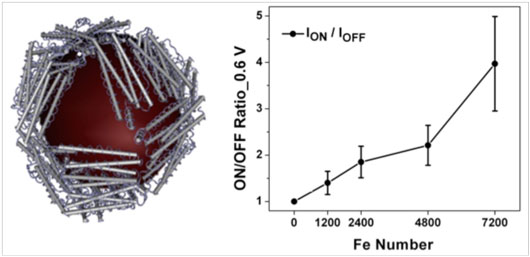| Posted: Dec 16, 2013 | |
Bioengineers use proteins to build a tunable memristor |
|
| (Nanowerk Spotlight) Based on the rapid development of synthetic chemistry and bioengineering, researchers have begun to build hybrid nanostructures with various biomolecules to fulfill the functional requirements of advanced nanocircuits. Proteins already perform functions such as signalling, charge transport or storage, in all biochemical processes. | |
| "Although the diversity of these natural molecules is vast – for instance, more than a million variants of an individual protein may be created via genetic engineering – tailoring their structures to fit the variable and complex requirements of both the biological and non-biological world is achievable by leveraging on the rapidly developing bioengineering field," Xiaodong Chen, an Associate Professor in the School of Materials Science & Engineering at Nanyang Technological University, tells Nanowerk. "On a parallel note, bioengineering may provide an alternative approach to tune the structural and electronic properties of functional molecules leading to further development in the field of molecular electronics." | |
| In a previous Nanowerk Spotlight ("First demonstration of a memristive nanodevice based on protein"), we reported on the work of Chen's group to demonstrate that proteins indeed can be used to fabricate bipolar memristive nanodevices. This work in 2011 provided direct proof that natural biomaterials, especially redox proteins, could be used to fabricate solid-state devices with transport junctions and can be the core component in the development of bioelectronic devices. | |
 |
|
| Bioengineered protein-based nanodevices with tunable and reproducible memristive performance are fabricated by modulating the iron amount inside Archaeoglobus fulgidus ferritin. Higher molecular loading exhibits better memristive performance owing to the higher electrochemical activity of the ferric complex core. (Image: Dr. Chen, Nanyang Technological University) | |
| Chen explains that the key parameter that defines the successful performance of memristive devices is the conductance switching. "The question is whether the memristive performance of such nanodevices can be modulated by leveraging bioengineering approaches or not." | |
| In new work, reported in a recent edition of Small ("Bioengineered Tunable Memristor Based on Protein Nanocage") Chen and his team demonstrate a strategy for the fabrication of memristive nanodevices with stable and tunable performance by assembling ferritin monolayer inside a on-wire lithography-generated ∼12 nm gap. | |
| Whereas the protein-based memristor devices in the previous work were fabricated from the commercial horse spleen ferritin, the new work uses the unique high iron loading capacity of Archaeoglobus fulgidus ferritin (AfFtn). | |
| "We hypothesized that if the composition of this iron complex core can be modulated, the switching performance of the protein-based device can be controlled accordingly," says Chen. | |
| They found that the (tunable) iron loading in the AfFtn nanocages drastically impacts the performance of the memristive devices. The higher iron loading amount contributes to better memristive performance due to higher electrochemical activity of the ferric complex core. | |
| "It is worth noting that the most important advantage of such ferritin for bioengineered memristive nanodevices is the controllability in the amount of iron loaded inside the protein – a key factor for achieving the tunable switching behavior," Chen points out. | |
| In a typical experiment, 5 µm long gold nanowires with 12 nm gaps were synthesized by on-wire lithography. Chen points out that the use of a chemical rather than physical method to fabricate the nanogaps accorded them a high degree of precision, down to 1 nm. Following e-beam lithography to remove the resist, gold and chromium were subsequently deposited to connect the nanowire and patterned microelectrodes on a Si/SiO2 chip. | |
| This work suggests that various protein molecules can be tailored using biotechnology to suit the specific requirements of molecular device development. | |
| "Our result provides another solid proof that hybrid nanostructures with biomolecules can be utilized in functional nanocircuits," Chen notes. "Bioengineering paves the way for future development in electronics and to gradually approach the higher-order target applications such as the construction of integrated electronic devices like neuromorphic computers." | |
| Although the use of biomolecules in fabricating nanoelectronic devices is promising, the stability of these molecular devices is not comparable with those based on traditional semiconductor materials. Chen and his team say that ensuring the stable molecular component and connections between molecules and electrodes will be a challenge for them. | |
 By
Michael
Berger
– Michael is author of three books by the Royal Society of Chemistry:
Nano-Society: Pushing the Boundaries of Technology,
Nanotechnology: The Future is Tiny, and
Nanoengineering: The Skills and Tools Making Technology Invisible
Copyright ©
Nanowerk LLC
By
Michael
Berger
– Michael is author of three books by the Royal Society of Chemistry:
Nano-Society: Pushing the Boundaries of Technology,
Nanotechnology: The Future is Tiny, and
Nanoengineering: The Skills and Tools Making Technology Invisible
Copyright ©
Nanowerk LLC
|
|
|
Become a Spotlight guest author! Join our large and growing group of guest contributors. Have you just published a scientific paper or have other exciting developments to share with the nanotechnology community? Here is how to publish on nanowerk.com. |
|
